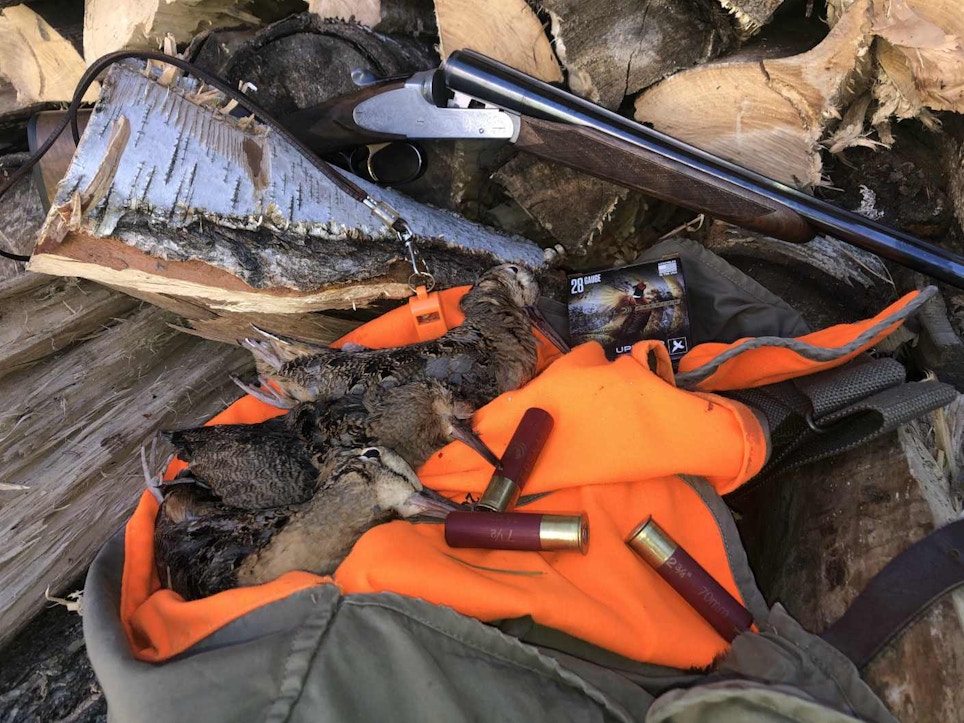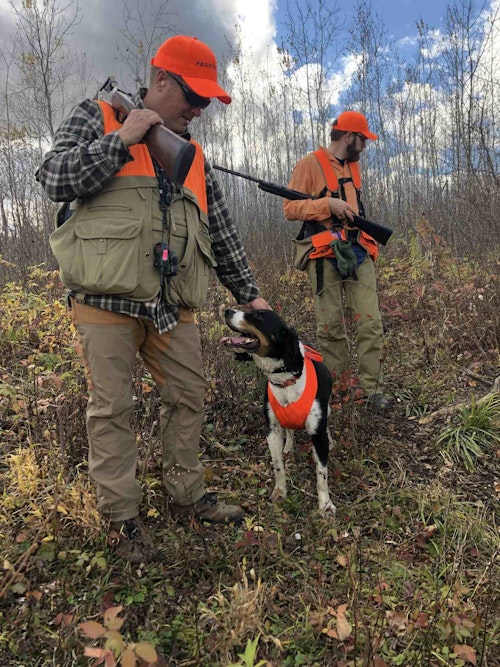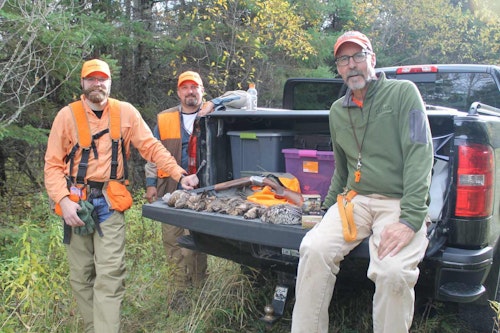
A limit of woodcock will be hard-earned but the effort is tempered by the scenery, dogs working hard and camaraderie with friends. (Photo: Gordy Krahn)
I suffer from mild depression approximately once every decade — coinciding perfectly with the decline of Minnesota’s ruffed grouse population as it crests the peak of its 10-year cycle and then tumbles toward the trough. Birds are everywhere one year and seemingly gone the next. And that’s why I squeeze every drop of enjoyment out of the precious good years when grouse numbers are high, knowing a severe drought is sure to follow.
Ruffed grouse are unique birds in many ways — secretive creatures of the boreal forest where I grew up in the northernmost reaches of the Gopher State. Homebodies, content to spend their entire lives within a hundred or so hectares of habitat, the bird’s small heart and short, clipped wings prevent sustained flight beyond a few hundred yards. And while habitat, weather, predation and other factors influence survival any given year, evidence points to the cycle as the overriding factor in determining overall grouse numbers — more pronounced in the bird’s primary range in the northeast than central hardwoods and southeastern bluff lands.
But I think I might have found a solution to those lean years when grouse numbers are at their lowest low. Being an equal opportunity hunter, I’ve taken the occasional American woodcock while grouse hunting, but have rarely targeted these speedy little migraters. And while it’s true they share the same habitat with grouse with a few subtle preferences, I’ve stubbornly held on to hunting grouse even when they’re as scarce as those proverbial hen’s teeth. That is, perhaps, until now.
The scenic ribbon of Highway 38 that meanders north of Grand Rapids, Minnesota, deposited me in quintessential grouse and woodcock country — a mixture of hard and soft woods laced with those uber-thick coverts these birds like to hang out in. While waning, fall colors were still vibrant — a palate of every imaginable shade of yellow, orange and red juxtaposed against a dark green conifer backdrop shimmering like a fresh oil painting. Chicken soup for the soul. And the mid-October timing was perfect — with northern flights of woodcock just beginning to pass through on their annual journey that would take them from their northern breeding grounds to the Gulf Coast and southeastern Atlantic Coast states where they spend their winters.
The woodcock is technically a migrating shorebird — a member of that family of long-beaked, long-legged birds most commonly seen on shorelines, wetlands and grasslands feeding on a wide variety of creepy crawlers. The woodcock, however, shuns those environs and instead prefers forest habitat — early growth aspen and birch, small forest openings, copses of tag alders and willows and such.
It was there I rendezvoused with two hunting buddies from Federal Ammunition — Brian Kelvington and Jon Zinnel — to have a go at these marvelous little game birds. Brian had hooked up with a local hunter/guide the previous year who, he told me, has the woodcock thing totally dialed in. He couldn’t have been more spot on. Chris Christy and his two-year-old GSP, Pepper, I soon discovered, hunt woodcock like they hate them. From listening to him talk, these little birds consume his every waking moment during the fall. Even when he’s on deer stand, he told me, he thinks about woodcock hunting. For him, the autumn hunt for grouse and woodcock is steeped in tradition, of family ties and a love for all things outdoors.
“My father was a big hunter, so I got out in the woods a lot when I was young,” Christy said. “We had an old hunting shack and we’d go out there every weekend and enjoy the outdoors. The comradery and just being outdoors are some of the best memories of my life. It’s tradition — just something you do when September comes around. You get that feeling in your bones that it’s time to get out in the woods.”
I swear, these words were out of his mouth before we’d even finished shaking hands. “I’d like to hit the really thick stuff if you don’t mind.” I’m guessing it was my salt-and-pepper beard that had him questioning my fortitude, but he seemed pleased with my response. “That’s fine, let’s go where the birds are.” And that’s where they were alright. Two hours of busting some of the thickest brush imaginable and we were two woodcock short of our 12-bird limit and had added two grouse to the bag to boot. Another short walk and we picked up our woodcock and one more grouse — a point, flush and retrieve by my elder Britt, Rebel. The perfect end to a perfect day.
I think it was when Christy casually mentioned that he prefers eating woodcock over ruffed grouse that I was compelled to examine his addiction for hunting these robin-sized speedsters at greater length. First off, he told me, it’s about the bird and about the numbers.
“It’s a very unique thing that very few people do,” he said about targeting woodcock over grouse. “I used to hunt grouse all the time but then the numbers went flat a little and I started to find these woodcock — to the point where grouse became secondary. I enjoy woodcock hunting more because I can go out and put up 50 birds in a day where if I go out grouse hunting, I’m lucky to put up 10 birds a day. I shoot a lot more and I get a lot more action by targeting woodcock.”
Perfect for Pointers
And for a guy with an honest pointing dog, woodcock provide the perfect compliment because they hold tight and allow the hunter to get into a relatively better position before flushing the bird. Mind you, even with a beeper, it might take 10 minutes to locate and get to your dog in the thick cover. And that’s why, Christy says, he prefers pointers over flushers for woodcock.
“I’d say your chances of having a successful hunt with a pointing dog is way higher than with a flushing dog on these birds because you get right up on them and then they flush,” he said. “A flushing dog is working out in front of you and when that bird gets up you rarely have a good shot because the cover is so thick. A pointing dog allows you get up on the bird and actually find a spot where you can swing the gun and get a decent shot."
Day two and we were back for more. Fanning out so we could cover more ground, each hunter was essentially hunting solo over his dog — hunting together but hunting apart. I smiled as Rebel’s beeper switched to the steady cadence that meant he’d stopped moving. That smile was quickly wiped from my face as I pushed forward through the brush and for the umpteenth time that day received a stinging slap to the cheek for my efforts. I rubbed my hand over the welt where the red willow had slipped my block and cursed under my breath. Pulling my cap down tight, I forged ahead until I saw a small patch of blaze orange vest in the thick undercover.
I slipped to Rebel’s right until I had a clear look of him on point and just enough room to maneuver my nimble Weatherby 28 gauge. I cursed again as a flurry of invisible winds erupted not 20 yards in front of me. The shot was purely instinctive — a reflex honed by a lifetime of hunting grouse. The angry swarm of Federal Upland Copper-Plated No. 7.5 pellets found the mark and the woodcock tumbled to the ground. Rebel was on him in an instant. It’s great when a plan comes together.

The Season of the Woodcock
Woodcock season opens in early September and initially revolves around local birds — those that nest in northern Minnesota.
“Early in the season you have a lot of local birds around and the past five years have been phenomenal,” Christy said. “There are birds everywhere and you don’t have much trouble filling out.” But it just gets better, he says, as northern birds begin moving down as cooler autumn temperatures and snow trigger the migration.
“About the second week of October the northerns start coming down,” Christy said. “The area here where we hunt is unique because when woodcock migrate from Canada they follow riverways and roadways. And here we have two rivers and Highway 6 that pretty much run north and south, and that provides a natural flyway for them. You know when you’re encountering northern birds because they’re exhausted from flying all night and don’t go very far after being flushed. They tend to be a bigger, hardier bird, and when you clean them they have a lot more fat on their bodies.”
It’s About the Dogs
Lost in our own thoughts, Christy and I quietly walked side-by-side down an overgrown logging road — watching our dogs work and enjoying the solitude of the woods. As I watched my present brace of Brittanys, Rebel (9) and Riot (1), work I couldn’t help but feel the bittersweet reality of owning gun dogs — one just beginning his stride, the other nearing the end of his. But for now it was all good as I watched what will soon be a changing of the guard — the pup acting like a seasoned dog and the seasoned dog acting like a pup. What could be more perfect?
And in the end it’s really about the dogs, isn’t it? It doesn’t matter if you’re hunting over a prim and proper Gordon setter or couch potato mixed-breed.
“Hunting with a dog — that bond — just makes all of this so much more special.” Christy had been reading my thoughts. “When your dog finds a bird, points it, flushes it up and retrieves it. When it all comes together — all of the training. If you haven’t done it, you just don’t understand.”
To truly love grouse and woodcock hunting is to adore those distinctive environs where they live — those hidey holes of thick alders and red willows, glistening birch and poplar ridges and dark reclusive spruce and cedar swamps. Most humans never encounter these secret places, consider them wastelands. Sadly, those poor souls never experience the exhilarating flush of these wild birds.
Avian biologists, those brainiacs who study the science of wild and domesticated birds, tell us the inevitable is upon us — that grouse numbers will soon take a nosedive toward the valley of the 10-year cycle. No worries. I now know that I can count on Minnesota’s other forest bird to fill the void.

Hunting with Kinder, Gentler Guns
Sub-gauge shotguns — 16-, 20- and 28-gauge and .410 — are gaining popularity with grouse and woodcock hunters and for good reasons. Gone are the days when one shotgun did it all for all types of flying fowl — when the 12-gauge was king of the forest. Grouse and woodcock don’t possess the fortitude of pheasants and waterfowl — therefore don’t require the heavy payloads that produce the bone-jarring recoil delivered by 12-gauge scatterguns. The lighter recoil of sub-gauge shotguns increases accuracy and allows the shooter to stay on target better for those inevitable follow-up shots. And when hunting the thick cover where these secretive birds hide out, a lightweight, maneuverable gun provides an advantage.
When hunting grouse/woodcock covers, I invariably do a lot more walking than shooting, and the considerable weight shed by toting a kinder, gentler sub-gauge gun is much appreciated. And I’m not alone.
“We’re seeing a resurgence in 16- and 28-gauge and sub-gauge shotguns overall,” Brian Kelvington, Media Director for Federal told me — new models entering the market and those old-timers handed down from father to son (or daughter). “And that’s why we added 28- and 16-gauge to the Prairie Storm ammo line this year [in addition to Federal’s full line of Upland copper-plated sub-gauge offerings].”
And with today’s advanced shotshell designs there is very little fall-off in performance when switching from 12-gauge to sub-gauges and their smaller payloads— aside from the number of pellets. If the hunter does his or her job of getting on target, these guns/ammo provide ample power and performance to anchor all varieties of flying fowl. Federal’s expansion of sub-gauge upland offerings provides a good example.
The 2.75-inch No. 7.5 Federal Upland 28-gauge High-Velocity loads that we packed on our grouse/woodcock hunt produce a muzzle velocity of 1,295 fps, plenty of horsepower for all upland birds. They feature copper-plated lead shot and high-quality components for consistent, deadly patterns — those needed to anchor fast-flying grouse and woodcock. The rule of thumb when hunting these birds is more pellets are better, and the No. 7.5 payloads deliver. MSRP: $25.99/Box of 25.
For pheasant hunters Federal has added 16- and 28-gauge offerings to the Prairie Storm lineup. An updated Flitecontrol Flex wad and a mixed payload of 70 percent standard copper-plated and 30 percent Flitestopper lead pellets — which create larger wound channels —produce even edge-to-edge patterns from these smaller payloads. The improved wad design can be used through both ported and standard upland chokes for even better patterning and versatility — a great choice for upland hunters pursuing pheasants, doves, quail, grouse and woodcock. And with a flurry of new guns on the market, 16-gauge Prairie Storm is the No. 1 requested product from Federal Premium consumers in the shotshell category, according to Kelvington. In addition to 12- and 20-gauge offerings, Prairie Storm is now available in 2.75-inch 16-gauge No. 4s, No. 5s and No. 6s as well as a 2.75-inch 28-gauge load No. 6 offering. MSRP: $34.99-$35.99/Box of 25.
And for upland hunters who find themselves hunting public land where non-toxic shot is mandatory, they can enjoy the performance of lead — without the heavy metal, thanks to Federal. With high-quality 9.6 g/cc density bismuth pellets, Federal Bismuth payloads pattern and hit birds like traditional lead, providing more killing power at longer ranges. The material is also softer than tungsten and steel, allowing use in older shotguns as well as modern guns. The new Bismuth loads are available in three 20-gauge offerings for sub-gauge upland hunters. MSRP: $62.99/Box of 25
Ruffed Grouse Society — Sixty Years Strong
The Ruffed Grouse Society will be celebrating its 60th anniversary in 2021 — its continuing mission focused on uniting conservationists to improve wildlife habitat and forest health.
With 124 volunteer chapters in 38 states, its membership is a diverse collective of conservationists with a passion for grouse and woodcock, supporting a science-based approach to wildlife conservation and forest management to ensure the future of these critical species on the local, regional and national levels. A healthy forest is a fully functioning ecosystem. It sequesters carbon, filters water, cleans the air and provides a home for wildlife. Research shows a clear link between the loss of forest age-class diversity and wildlife declines
Grouse and woodcock are the bellwethers of forest health and their relative health mirrors trends for dozens of forest wildlife species — a canary in the coal mine for migratory and non-migratory birds, rabbits and hares, moose, etc. And it’s the RGS chapters that provide a local focus and kinship to support land management projects that improve conditions for ruffed grouse, woodcock and the species that are associated with the environments in which they live.
To learn more about the mission of the Ruffed Grouse Society and American Woodcock Society, visit www.ruffedgrousesociety.org.







